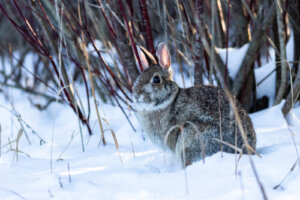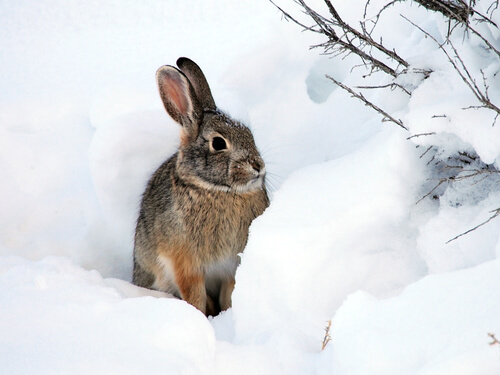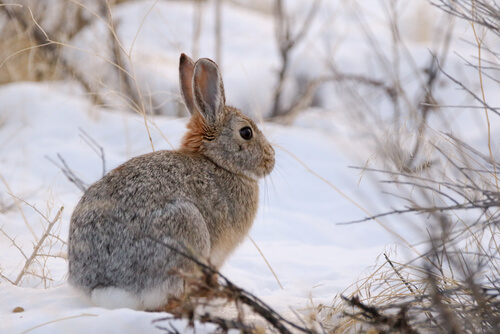How to Keep Rabbits Warm in Winter


Written and verified by biochemistry Luz Eduviges Thomas-Romero
Keeping your rabbits warm in winter should be one of your priorities. Rabbits often live outdoors, and they’re happy this way. However, you may feel it’s cruel to leave your rabbits outside during the winter months.
It’s important to note that moving a rabbit indoors during the winter is riskier than leaving it outside. Sudden changes in temperature can seriously affect your rabbit’s health. Thus, the best measure is to insulate your rabbit hutch and regularly monitor its temperature.
At what body temperature should you intervene to keep your rabbits warm in winter?
Despite their fragile appearance, rabbits are quite resilient when it comes to dealing with cold weather. A rabbit’s organism will always be in better condition in a cold climate than in a warm one.
The average body temperature of a healthy rabbit is 38 to 39 degrees Celsius. This body temperature is maintained even when outside temperatures are near 0 degrees Celsius, and even lower.

As a caregiver, you should monitor your rabbits’ body temperature regularly throughout the winter. If your rabbit is above 38 degrees Celsius, your rabbit is healthy. However, if your rabbit’s temperature is at 37 degrees Celsius or below, your pet has hypothermia and you should act immediately.
What are the symptoms of hypothermia in rabbits?
It’s critical to be able to recognize the signs of hypothermia in rabbits. In addition to body temperature, you should be aware of the following symptoms:
- Cool extremities, such as the tips of the ears and legs.
- Cool to the touch and pale appearance.
- Uncharacteristic lethargy. Most rabbits are more active in cool temperatures.
- A weak and unstable heartbeat.
- Shallow breathing.
- Lack of coordination and possible loss of consciousness.

How to treat hypothermia in rabbits
Treating a hypothermic rabbit is relatively simple; the main aspect is to warm them up quickly. Wrap your rabbit in a thick towel or blanket and bring it into your home. Once you have done this, raise their body temperature and take them to the vet immediately. There are two simple techniques for first aid:
- Fill a bottle with warm water and let your rabbit lie on it. Remember that the water should be hot, but not hot enough to burn your rabbit.
- Place a towel in the microwave for 30 seconds. Repeat this until the towel is warm, but not hot enough to be dangerous for your rabbit. Wrap the bunny in the warm towel.
Keeping rabbits warm in winter: can rabbits live outside all year round?
You will notice that your rabbit wants more exercise during the winter. This is natural, as rabbits become more playful when the temperature drops. Allow your rabbit to run and play in the yard during the winter, but be careful not to let it get its fur wet. A rabbit’s body temperature can drop sharply if it’s wet.
You can take several steps to keep outdoor rabbits safe throughout the winter. These include:
- Make sure your bunny’s hutch has a reliable, dry, and secure roof. Also, make sure to check it regularly to detect any problems early.
- The hutch should not be in direct contact with the ground, as moisture could infiltrate and affect your pet’s temperature.
- Place a lid over the door of your rabbit’s hutch, preferably clear plastic so your rabbit can see outside. This prevents cold air from entering without completely enclosing your rabbit.
- Provide a cardboard box filled with hay. Your rabbit will use this as a separate, warmer “bedroom”.
- Try to increase the amount of substrate. This will allow it to maintain the warmth of its home.
- Make sure there are no direct drafts in the hutch, but allow for airflow. Otherwise, your rabbit may suffocate.
- Regularly check your rabbit’s water; make sure it hasn’t frozen. If necessary, offer your rabbit hot chamomile tea to warm it up.
- Clean your rabbit’s hutch during the winter. Straw and hay get wet in cold conditions and make the inside of the hutch cold.
- Increase your rabbit’s food intake a little during the winter months. They will burn more energy by keeping warm. Don’t worry about their weight, as they’ll also get more exercise.
Remember that rabbits don’t go through hibernation. This means that any signs of lethargy or little activity should be considered a risk to their health. If you notice unusual behavior in your pet during the winter, bundle them up warmly and see a veterinarian immediately.
Keeping your rabbits warm in winter should be one of your priorities. Rabbits often live outdoors, and they’re happy this way. However, you may feel it’s cruel to leave your rabbits outside during the winter months.
It’s important to note that moving a rabbit indoors during the winter is riskier than leaving it outside. Sudden changes in temperature can seriously affect your rabbit’s health. Thus, the best measure is to insulate your rabbit hutch and regularly monitor its temperature.
At what body temperature should you intervene to keep your rabbits warm in winter?
Despite their fragile appearance, rabbits are quite resilient when it comes to dealing with cold weather. A rabbit’s organism will always be in better condition in a cold climate than in a warm one.
The average body temperature of a healthy rabbit is 38 to 39 degrees Celsius. This body temperature is maintained even when outside temperatures are near 0 degrees Celsius, and even lower.

As a caregiver, you should monitor your rabbits’ body temperature regularly throughout the winter. If your rabbit is above 38 degrees Celsius, your rabbit is healthy. However, if your rabbit’s temperature is at 37 degrees Celsius or below, your pet has hypothermia and you should act immediately.
What are the symptoms of hypothermia in rabbits?
It’s critical to be able to recognize the signs of hypothermia in rabbits. In addition to body temperature, you should be aware of the following symptoms:
- Cool extremities, such as the tips of the ears and legs.
- Cool to the touch and pale appearance.
- Uncharacteristic lethargy. Most rabbits are more active in cool temperatures.
- A weak and unstable heartbeat.
- Shallow breathing.
- Lack of coordination and possible loss of consciousness.

How to treat hypothermia in rabbits
Treating a hypothermic rabbit is relatively simple; the main aspect is to warm them up quickly. Wrap your rabbit in a thick towel or blanket and bring it into your home. Once you have done this, raise their body temperature and take them to the vet immediately. There are two simple techniques for first aid:
- Fill a bottle with warm water and let your rabbit lie on it. Remember that the water should be hot, but not hot enough to burn your rabbit.
- Place a towel in the microwave for 30 seconds. Repeat this until the towel is warm, but not hot enough to be dangerous for your rabbit. Wrap the bunny in the warm towel.
Keeping rabbits warm in winter: can rabbits live outside all year round?
You will notice that your rabbit wants more exercise during the winter. This is natural, as rabbits become more playful when the temperature drops. Allow your rabbit to run and play in the yard during the winter, but be careful not to let it get its fur wet. A rabbit’s body temperature can drop sharply if it’s wet.
You can take several steps to keep outdoor rabbits safe throughout the winter. These include:
- Make sure your bunny’s hutch has a reliable, dry, and secure roof. Also, make sure to check it regularly to detect any problems early.
- The hutch should not be in direct contact with the ground, as moisture could infiltrate and affect your pet’s temperature.
- Place a lid over the door of your rabbit’s hutch, preferably clear plastic so your rabbit can see outside. This prevents cold air from entering without completely enclosing your rabbit.
- Provide a cardboard box filled with hay. Your rabbit will use this as a separate, warmer “bedroom”.
- Try to increase the amount of substrate. This will allow it to maintain the warmth of its home.
- Make sure there are no direct drafts in the hutch, but allow for airflow. Otherwise, your rabbit may suffocate.
- Regularly check your rabbit’s water; make sure it hasn’t frozen. If necessary, offer your rabbit hot chamomile tea to warm it up.
- Clean your rabbit’s hutch during the winter. Straw and hay get wet in cold conditions and make the inside of the hutch cold.
- Increase your rabbit’s food intake a little during the winter months. They will burn more energy by keeping warm. Don’t worry about their weight, as they’ll also get more exercise.
Remember that rabbits don’t go through hibernation. This means that any signs of lethargy or little activity should be considered a risk to their health. If you notice unusual behavior in your pet during the winter, bundle them up warmly and see a veterinarian immediately.
All cited sources were thoroughly reviewed by our team to ensure their quality, reliability, currency, and validity. The bibliography of this article was considered reliable and of academic or scientific accuracy.
- Vrbjar, N., Kean, K. T., Szabo, A., Senak, L., Mendelsohn, R., & Keough, K. M. W. (1992). Sarcoplasmic reticulum from rabbit and winter flounder: temperature-dependence of protein conformation and lipid motion. Biochimica et Biophysica Acta, 1107(1), 1–11.
- Díez, C., Paez, J. A., Prieto, R., Alonzo, M. E., & Olmedo, J. A. (2005). Activity Patterns of Wild Rabbit ( Oryctolagus cuniculus , L.1758), under Semi-Freedom Conditions, during Autumn and Winter. Wildlife Biology in Practice, 1(1), 41–46.
- Xiu-ling, Z. (2009). Environmental Examination and Estimation of Rabbit Hut in Winter. Shandong Agricultural Sciences.
This text is provided for informational purposes only and does not replace consultation with a professional. If in doubt, consult your specialist.








